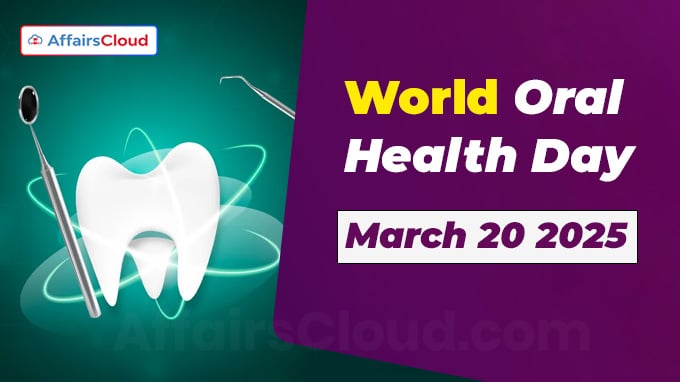 World Oral Health Day (WOHD) is observed annually on March 20 across the globe to raise awareness about the significance of oral health and to support efforts aimed at reducing the burden of oral diseases on individuals, health systems, and economies. The day also empowers individuals with knowledge and tools to prevent and control oral diseases affecting 3.5 billion people worldwide
World Oral Health Day (WOHD) is observed annually on March 20 across the globe to raise awareness about the significance of oral health and to support efforts aimed at reducing the burden of oral diseases on individuals, health systems, and economies. The day also empowers individuals with knowledge and tools to prevent and control oral diseases affecting 3.5 billion people worldwide
- This global observance is led by the FDI World Dental Federation (Fédération Dentaire Internationale – FDI), which brings together the world of dentistry to achieve optimal oral health for everyone.
Theme 2025:
i.The WOHD campaign theme for 2024–2026 is “A Happy Mouth is…A Happy Mind”, emphasizes the relationship between oral health and overall well-being, highlighting how prioritizing oral health can lead to better mental health.
ii.Toothie, FDI’s mascot, joins the 3-year campaign, focusing on a transformative journey where prioritizing oral health leads to better health overall.
Background:
i.WOHD was first declared in 2007 and was originally celebrated on September 12, the birth date of FDI founder Dr. Charles Godon.
ii.In 2013, the date of observance was changed to March 20 to avoid conflict with the FDI World Dental Congress taking place in September.
Why March 20?
i.The new date March 20 was chosen to reflect that:
- Seniors must have a total of 20 natural teeth at the end of their life to be considered healthy.
- Children should possess 20 baby teeth.
- Healthy adults must have a total of 32 teeth and 0 dental cavities.
ii.Expressed on a numerical basis, this can be translated as 3/20, hence represented as March 20.
Global Challenges:
i.Oral diseases impact physical, emotional, mental, and social well-being. The South-East Asia (SEA) region reports approximately 900 million cases, reflecting its large population.
- The region has the highest global burden of oral cancer, with 11.2% of cases among males.
ii.High consumption of smokeless tobacco and areca nut contributes to this burden; eliminating these could prevent half of oral cancer cases.
iii.Through the South-East Asia Regional Action Plan for Oral Health 2023–2030, the World Health Organisation (WHO) aims for Universal Health Coverage (UHC) by 2030.
iv.In November 2024, the inaugural Global Oral Health Meeting in Bangkok Thailand facilitated knowledge exchange, resulting in National Oral Health Roadmaps (NOHR).
- WHO is developing a regional roadmap to address oral cancer linked to smokeless tobacco and areca nut use to achieve universal oral health by 2030.
v.A capacity-building project was launched in Kenya, Tanzania, and Zambia to improve access to WHO-listed dental materials, supported by Japan’s Ministry of Health, Labour, and Welfare.
National Programme:
i.India’s National Oral Health Programme (NOHP) was launched in 2014–2015 to integrate comprehensive oral healthcare into existing healthcare facilities.
ii.Initially implemented in 9 states, the programme has now expanded to 32 States/Union Territories (UTs) across India.
Key Facts:
i.Dental Caries: An estimated 2.3 billion individuals suffer from tooth decay in permanent teeth, making it the most common health condition globally.
ii.Children’s Oral Health: Over 530 million children experience tooth decay in their primary teeth.
iii.Gum Disease: Severe periodontal (gum) disease affects nearly 1 billion people globally.
iv.Tooth Loss: Complete tooth loss impacts around 350 million individuals worldwide.
v.Oral Cancer: Annually, there are approximately 380,000 new cases of oral cancer globally.
About FDI World Dental Federation (FDI):
The FDI is a non-governmental organization (NGO) and one of the oldest professional organizations in the world.
Executive Director (ED)– Enzo Bondioni
Headquarters– Geneva, Switzerland
Established– 1900




